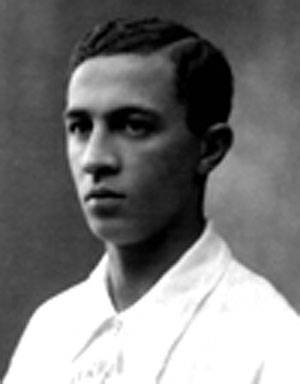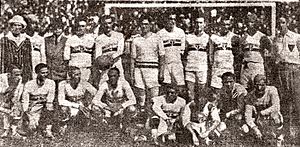Arthur Friedenreich facts for kids

Friedenreich with Brazil
|
|||||||||||||||||||||||||
| Personal information | |||||||||||||||||||||||||
|---|---|---|---|---|---|---|---|---|---|---|---|---|---|---|---|---|---|---|---|---|---|---|---|---|---|
| Date of birth | 18 July 1892 | ||||||||||||||||||||||||
| Place of birth | São Paulo, Brazil | ||||||||||||||||||||||||
| Date of death | 6 September 1969 (aged 77) | ||||||||||||||||||||||||
| Place of death | São Paulo, Brazil | ||||||||||||||||||||||||
| Height | 1.70 m (5 ft 7 in) | ||||||||||||||||||||||||
| Position(s) | Striker | ||||||||||||||||||||||||
| Senior career* | |||||||||||||||||||||||||
| Years | Team | Apps | (Gls) | ||||||||||||||||||||||
| 1909 | Germânia | 1 | (0) | ||||||||||||||||||||||
| 1910 | Ypiranga | 2 | (0) | ||||||||||||||||||||||
| 1911 | Germânia | 13 | (6) | ||||||||||||||||||||||
| 1912 | Mackenzie College | 11 | (12) | ||||||||||||||||||||||
| 1913–1915 | Ypiranga | 32 | (21) | ||||||||||||||||||||||
| 1916 | Paysandu | 6 | (4) | ||||||||||||||||||||||
| 1917 | Ypiranga | 6 | (15) | ||||||||||||||||||||||
| 1918–1929 | Paulistano | 252 | (288) | ||||||||||||||||||||||
| 1930–1935 | São Paulo | 124 | (102) | ||||||||||||||||||||||
| 1933 | Atlético Mineiro | ||||||||||||||||||||||||
| São Paulo | |||||||||||||||||||||||||
| 1935 | Flamengo | 4 | (0) | ||||||||||||||||||||||
| International career | |||||||||||||||||||||||||
| 1914–1925 | Brazil | 23 | (10) | ||||||||||||||||||||||
| 1922–? | São Paulo | ? | (?) | ||||||||||||||||||||||
|
Medal record
|
|||||||||||||||||||||||||
| *Club domestic league appearances and goals | |||||||||||||||||||||||||
Arthur Friedenreich (born July 18, 1892 – died September 6, 1969) was a famous Brazilian footballer. He played as a forward and was known by nicknames like The Tiger. He was one of the first mixed-race players to become a star in football.
Friedenreich played football when it was still an amateur sport in Brazil, meaning players weren't paid. This changed in 1933 when football became professional. Some people say he scored more goals than anyone else in football history, but this is a debated topic.
Contents
Arthur Friedenreich's Life Story
Early Life and Family
Arthur Friedenreich was born in São Paulo, Brazil. His father, Oscar Friedenreich, was a German businessman. His mother, Mathilde, was a Black Brazilian washerwoman whose parents were freed slaves.
Arthur was one of the first professional football players of Afro-Brazilian background. At that time, football was mostly played by white people, and Black players faced many challenges. He experienced racism and was often not allowed in places like swimming pools or parties where white players went. It was also hard for him to make friends in the Brazilian football world because of his skin color.
Arthur loved playing football from a young age. His father really supported his talent and helped him become the great player he was. Later in life, Arthur married his wife, Jonas, and they had a son named Oscar, after Arthur's father.
His Unique Playing Style
Friedenreich is often seen as the person who started jogo bonito, which means 'the beautiful game'. This style is now famous in Brazilian football. It involves playing very fast with short passes and quick touches. Players also take many long shots and attack with 2-3 speedy forwards to confuse the other team's defense.
Even though he was not very tall (about 1.70 meters), he was known for his speed, strength, and amazing dribbling skills.
Starting His Football Career
Arthur began his career playing for SC Germânia, a team made up of German immigrants. He joined the national team in 1914. This was Brazil's very first football game, and they won 2–0 against Exeter City. In that game, Arthur famously lost two front teeth from a hard tackle!
He played 22 international games for Brazil and scored 10 goals. He helped Brazil win the South American Championship in 1919 and 1922. In the 1919 tournament, he was the first player ever to score three goals in one game (a hat-trick) in a major international competition. When Brazil toured Europe in 1925, people called him the King of Football.
Arthur was also the top scorer in the São Paulo League many times. He was very young when he developed his unique playing style. He was only 17 when he joined an important club. He played for several clubs before finding a long-term home with CA Paulistano, a top Brazilian club. He stayed there for 12 years until the club closed down. After that, he joined São Paulo da Floresta.
Later Years in Football
Arthur was not chosen to play for Brazil in the 1930 FIFA World Cup. This was because of a disagreement between the football leagues of Rio de Janeiro and São Paulo states. Only players from Rio went to the World Cup. So, São Paulo stars like Arthur (who was 38 at the time) could not go.
He continued to play for less famous clubs as he got older. After 1934, he mostly played in local games. His last team before he retired in 1935 was Flamengo from Rio de Janeiro. He retired very late in his career, at 43 years old.
Life After Football
In the 1930s, Brazilian football started to become professional, meaning players would get paid. This became official in 1933. Arthur Friedenreich was against this change. He was so upset that he decided to stop playing football. His last match was for Flamengo against Fluminense on July 21, 1935. The game ended in a 2–2 tie, and he didn't score that day.
After retiring, he worked for a company that sold drinks. Later in his life, Arthur developed Alzheimer's disease. The treatment for this illness used up most of his money. He lived in a house given to him by the São Paulo football club until he passed away on September 6, 1969, at the age of 77.
Remembering Arthur Friedenreich
There are several places named after Arthur Friedenreich to honor him.
- A park in the Vila Alpina neighborhood of São Paulo.
- A street in the east side of São Paulo.
- A school in Rio de Janeiro, located near the famous Maracanã sports complex.
Facing Discrimination in Football
Arthur Friedenreich was of mixed race, with both German and Afro-Brazilian heritage. Brazil was one of the last countries to end slavery, which happened in 1888, just four years before Arthur was born. Because of this, Arthur faced a lot of discrimination throughout his life and football career.
For example, he was not allowed to play in the 1921 South American Championship in Argentina. While Arthur never became a public speaker against discrimination, he broke many barriers just by playing football. He also tried to fit in by making himself appear more white. He would dress, act, and behave like many white players. Some Black players in Brazil would even put flour or rice powder on their faces to look whiter. Arthur would often spend a lot of time straightening his hair before games to look "white."
Playing Record
Clubs Arthur Played For
- 1909: Germânia
- 1910: Ypiranga
- 1911: Germânia
- 1912: Mackenzie College
- 1913: Ypiranga
- 1913: Americano from Santos
- 1913–14: Paulista
- 1914: Atlas* (Atlas Flamengo FC from Santos)
- 1914–15: Ypiranga
- 1915–16: Payssandu
- 1916: Paulistano
- 1917: Ypiranga
- 1917: Flamengo
- 1917–29: Paulistano
- 1929: Internacional*
- 1929: Atlético Santista*
- 1930: Santos*
- 1930–35: São Paulo
- 1933: Dois de Julho (BA)*
- 1933: Atlético*
- 1935: Santos
- 1935: Flamengo
- *) played for just one match.
Top Scorer Awards
Arthur Friedenreich was the top scorer in the Liga Paulista in these years:
| Year | Club | Goals |
|---|---|---|
| 1912 | Mackenzie College | 12 |
| 1914 | Paulistano | 12 |
| 1917 | Ypiranga | 15 |
| 1918 | Paulistano | 25 |
| 1919 | Ypiranga | 26 |
| 1921 | Paulistano | 33 |
| 1927 | Paulistano | 13 |
| 1928 | Paulistano | 29 |
| 1929 | Paulistano | 16 |
Sometimes, because of disagreements that split the league, he shared the top scorer title with other players:
| Year | Player | Club | Goals |
|---|---|---|---|
| 1914 | Neco | Corinthians | 12 |
| 1927 | Araken | Santos | 31 |
| 1928 | Heitor | Palestra Itália | 16 |
| 1929 | Feitiço | Santos | 12 |
Honors and Awards
- Campeonato Paulista: 1918, 1919, 1921, 1926, 1927, 1929, 1931
With Brazil National Team
- South American Championship: 1919, 1922
- Roca Cup: 1914
Individual Awards
- South American Championship player of the tournament: 1919
- South American Championship top scorer: 1919
- IFFHS Brazilian Player of the 20th Century (5th place)
- IFFHS South American Player of the 20th Century (13th place)
See Also
 In Spanish: Arthur Friedenreich para niños
In Spanish: Arthur Friedenreich para niños
- German Brazilians
Images for kids






